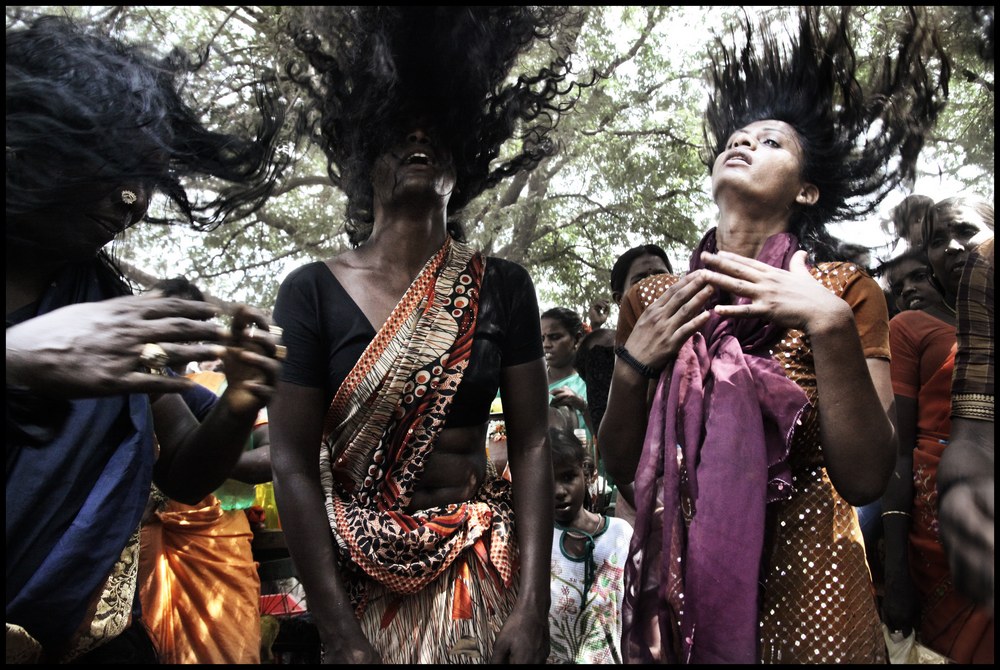The presiding deity of the temple at Koovagam, a tiny village in South India, is Aravan. In the Mahabharata it was prophesised that the Pandavas would win the battle of Kurukshetra only if they sacrificed a ‘perfect’ male from among themselves. Aravan, the virgin son of Pandav prince Arjuna, offered himself up for sacrifice. But he had a request- that he be allowed to spend one night as a married man. As no king was willing to give his daughter in marriage only to have her widowed the next day, Lord Krishna assumed female form and married Aravan, and after a night of sexual bliss, Aravan was beheaded.
Every year, during the first full moon of the Tamil month of Chittirai, thousands of aravanis (transgenders) converge at Koovagam in Villupuram district of Tamil Nadu from all over from India to commemorate this ancient narrative. The aravanis identify themselves with Mohini, the female form that Lord Krishna had assumed for his night with Aravan. Hence they call themselves aravanis—wives of Aravan.
At the temple grounds, dressed in their traditional best, thousands of visiting aravanis act out the role of Aravan’s bride. Inside the temple, amid a breathless crush of jostling bodies, clanging bells and the overpowering smell of the burning camphor, the priests marry the aravani- they tie turmeric-coated sacred marital threads around the aravanis’ necks and hands and allow them a splitsecond audience with the idol of Aravan.
Later, the aravanis celebrate their ‘wedding night’ through countless acts of sex. As dawn breaks, the aravanis emerge to mourn the inevitable death of their mythical husband. The aravanis then don widow’s weeds (white cloths), break their bangles and grieve with an intense—albeit rather contrived—passion.

Aravanis preparing for the festival.


Aravanis as they enter the festival or Aravan at Koovagam.

A 13-year-old priest marries an aravani in the temple at Koovagam.


An aravani pays her respects to the priest who married her.

Brides jostle for space inside the temple.

A married aravani.


Aravanis and locals gather outside the temple of Aravan.


Aravanis express their agony through traditional folk dances.


As dawn breaks, the aravanis emerge to mourn the inevitable death of their mythical husband.


A young priest breaks the wedding bangles.

An aravani cries as a priest cuts the Thaali (turmeric-coated sacred marital threads) from her neck.

Groups mourn the death of aravan.

The severed Thaalis are thrown on to a holy pillar and worshipped.


Aravanis in widow’s weeds (white clothes).
Bio:
Senthil Kumaran was born 1977 in Madurai. After studying computer science in Madurai University, he worked as a software engineer in the Indian defense sector. Meanwhile, he pursued photography, and in 2001 he quit his software job and took up photography as a fulltime vocation. He photographed whatever he came across on his daily life, but soon began to focus on social and cultural documentary photography. He has won several international awards inclusing ones from UNESCO, NatGeo, WWF, City Magazine, Photo Life Magazine, Outdoor Photography and Nature Image awards. In 2005 he was one among the 114 young global photographers nominated for the World Press Photo Joop Swart Masterclass and in 2007, was awarded the “Geographical Photographer of the Year” from Royal Geographic Society, London. His photographs have appeared in all leading publications in India.
He now works as a distributing photographer with Trikaya Photo Agency, Chennai.





